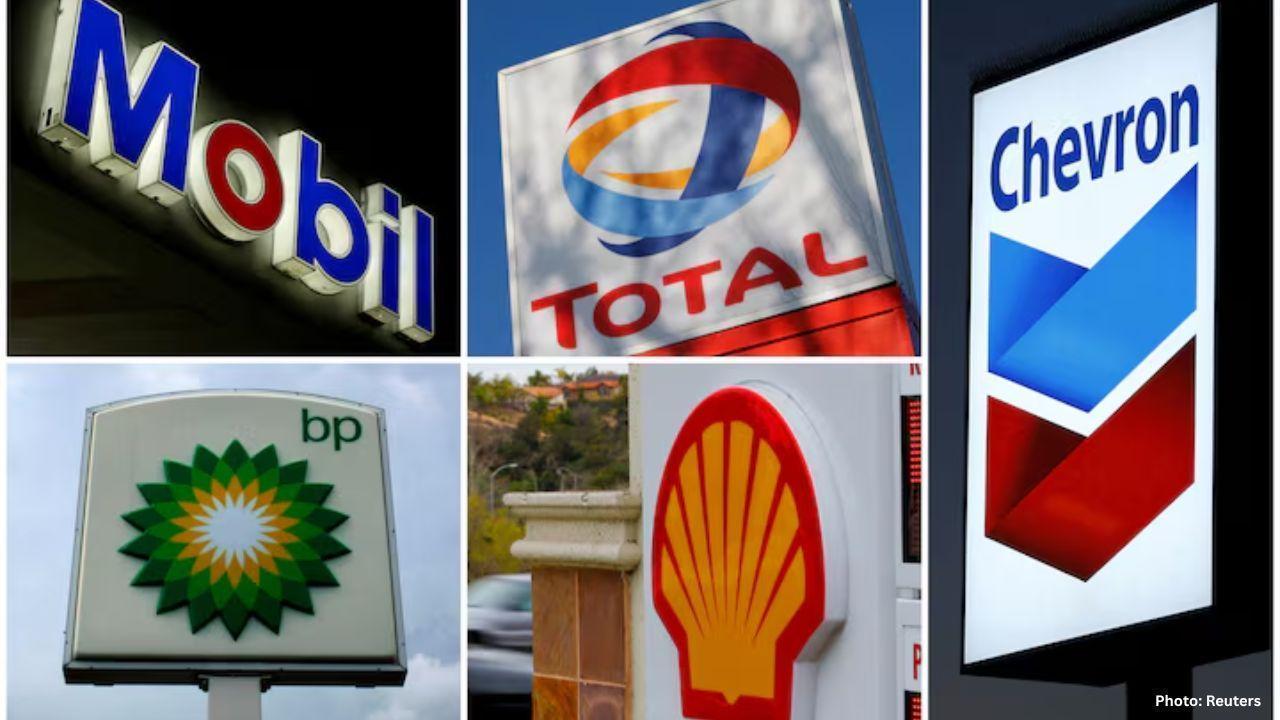
Post by : Monika
The global oil industry is currently facing a period of financial pressure as oil prices have fallen from the highs seen in recent years. Major oil companies, including Chevron, ExxonMobil, BP, Shell, and TotalEnergies, are struggling to maintain their traditional levels of shareholder payouts and operations.
These companies have paid out over $100 billion annually to shareholders since 2022 through dividends and share buybacks, but with oil prices dropping below the levels needed to sustain these payouts, they are now under significant pressure.
The drop in oil prices is largely due to a combination of increased production, slowing global economic growth, and geopolitical uncertainties, which have all contributed to a surplus in the oil market. With the cost of operations remaining high, these companies are now forced to reconsider their spending priorities, reduce costs, and even cut jobs to remain financially viable.
Why Are Oil Prices Falling?
Oil prices are influenced by multiple factors, and recent trends have led to a decline that is affecting the financial health of major oil companies.
Increased Global Oil Production:
Several countries have increased oil production, adding to the global supply. Countries outside the Organization of the Petroleum Exporting Countries (OPEC) have also contributed to this increase, resulting in a surplus of oil in the market. When supply exceeds demand, prices naturally decrease.
Economic Concerns:
Global economic uncertainty, including fears of a slowdown in major economies, reduces demand for oil. Industries slow production, transportation declines, and less energy is consumed, all contributing to lower oil prices.
Geopolitical Events:
Conflicts and political instability, such as the Russia-Ukraine war, have disrupted oil markets. While such events can sometimes push prices higher due to supply concerns, market overreaction and uncertainty can also cause volatility and lead to price drops.
As a result, oil prices have fallen below $65 per barrel, which is less than the $80 per barrel that most major oil companies require to maintain their current shareholder payouts. This gap has raised concerns about the sustainability of large dividends and stock buybacks.
Financial Pressure on Big Oil
The financial pressure from lower oil prices has forced big oil companies to rethink their spending strategies. These companies had historically paid large sums to shareholders, which include:
While these payments have been popular with investors, they are not sustainable when oil revenues fall. Analysts predict that without changes, companies may need to borrow more money, reduce payouts, or both.
Actions Taken by Oil Companies
In response to the falling oil prices, oil companies are implementing several measures to preserve financial stability:
Reducing Share Buybacks:
Companies like TotalEnergies, BP, and Chevron have announced reductions in their share buyback programs. This helps them conserve cash and reduce debt pressure while maintaining operations.
Cost Reduction Measures:
TotalEnergies has announced a plan to cut costs by $7.5 billion by 2030. Other companies are also reviewing operational expenses, delaying non-essential projects, and optimizing spending to remain financially stable.
Job Reductions:
More than a dozen energy companies, including ExxonMobil, Chevron, Shell, and BP, have announced job cuts for 2025 and 2026. This move, while necessary for financial management, has significant social and economic impacts on employees and communities reliant on these jobs.
These steps are essential for maintaining profitability and preventing debt from spiraling as oil revenues decline.
Impact on Shareholders
Shareholders of these oil companies have enjoyed high returns through dividends and share buybacks. However, the drop in oil prices may reduce shareholder payouts in the near future. Analysts from banks such as Citi and Goldman Sachs have predicted that oil prices could fall further, possibly into the $50-$60 per barrel range next year.
If oil prices continue to decline, companies may need to make more significant reductions in dividends and stock buybacks. This could impact investor confidence and reduce the attractiveness of oil company stocks. Long-term investors may face lower returns until market conditions improve.
Job Losses:
Employee layoffs affect thousands of workers and their families. Communities that rely on employment from oil companies may experience economic stress due to reduced spending and employment.
Local Economies:
Areas dependent on oil company operations may face slower economic activity. Small businesses, suppliers, and contractors that work with oil companies may also feel the impact of reduced contracts and investment.
Global Energy Markets:
Oil prices influence energy costs worldwide. Lower prices can reduce costs for consumers but can also slow investment in new energy projects, including renewable energy initiatives.
Financial Stability:
Companies must balance shareholder demands with financial sustainability. Mismanagement or excessive debt can create instability not just for the company but also for the broader financial market.
Future Outlook
The future of big oil companies depends on multiple factors:
Oil Price Recovery:
If oil prices rise again due to market adjustments or geopolitical factors, companies may regain financial stability and resume higher payouts to shareholders.
Effective Cost Management:
Companies that successfully cut costs and streamline operations can remain profitable even at lower oil prices.
Global Demand:
A recovery in global demand for oil will support higher prices and provide stability for oil companies.
Strategic Investment:
Investing in new technologies and alternative energy sources can help oil companies diversify revenue and reduce reliance on volatile oil prices.
Investors, employees, and stakeholders are closely monitoring these developments to understand how companies will navigate the current challenges.
Role of Analysts and Experts
Financial experts have emphasized the importance of balancing payouts with operational sustainability. High dividends and buybacks during periods of low oil prices are not sustainable and can jeopardize long-term company health. Analysts suggest that companies focus on:
Falling oil prices have created a challenging environment for the world’s largest oil companies. Chevron, ExxonMobil, BP, Shell, and TotalEnergies are under pressure to cut costs, reduce jobs, and limit payouts to shareholders. These measures are necessary to maintain financial stability and protect the companies from debt and operational risks.
The situation illustrates the volatility of the oil market and how it directly impacts company finances, employees, investors, and local economies. While lower oil prices can be beneficial for consumers, they create significant challenges for producers, who must adjust to maintain profitability.
Going forward, the recovery of oil prices, effective cost management, and strategic investment decisions will determine how these companies navigate this period of financial pressure. Employees, investors, and stakeholders must prepare for potential disruptions in payouts, jobs, and operations until market conditions stabilize.










OpenAI Highlights Growing Cybersecurity Threats from Emerging AI Technologies
OpenAI has raised alarms about the increasing cyber risks from its upcoming AI models, emphasizing s

Manchester City Triumphs 2-1 Against Real Madrid, Alonso Faces Increased Scrutiny
Manchester City secured a 2-1 victory over Real Madrid, raising concerns for coach Xabi Alonso amid

Cristiano Ronaldo Leads Al Nassr to 4-2 Victory Over Al Wahda in Friendly Face-Off
Ronaldo's goal helped Al Nassr secure a 4-2 friendly win over Al Wahda, boosting anticipation for th

Landon Donovan Challenges Australia Coach on World Cup Prospects
Landon Donovan counters Australia coach Tony Popovic’s optimism for the World Cup, expecting an earl

Mercedes-Benz Forms Landmark Partnership with WTA
Mercedes-Benz and the WTA unveil a significant partnership effective January 2026, with major invest

Abhishek Addresses Divorce Rumours Concerning His Family
Abhishek Bachchan confirms that daughter Aaradhya remains oblivious to divorce speculations, focusin